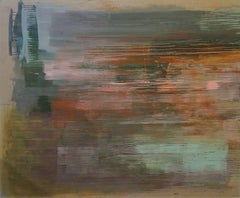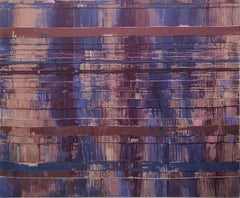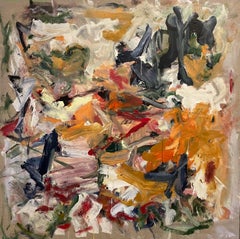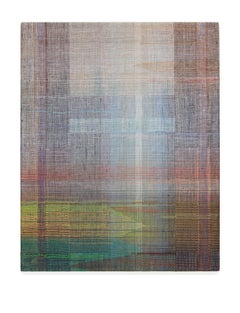Raw Linen Landscape Paintings
to
2
Overall Width
to
Overall Height
to
2
2
2
2
67
3
3
3
3
3
2
1
1
2
Medium: Raw Linen
Artist: Jeanette Fintz
Sayan Terrace (Contemporary Abstract Painting on Raw Linen)
Located in Hudson, NY
60 x 72 x 1.5 inches
acrylic on canvas being offered by CARRIE HADDAD GALLERY in Hudson, NY.
Large, horizontal abstract painting with a palette of turquoise, saffron orange, teal an...
Category
1990s Contemporary Raw Linen Landscape Paintings
Materials
Raw Linen, Acrylic
Tirtaggana (Contemporary Abstract Violet Painting on Stitched Raw Linen)
Located in Hudson, NY
60 x 72 x 1.5 inches
acrylic on canvas
This painting is being offered by Carrie Haddad Gallery, located in Hudson, NY.
Tirta gangga means WATER PALACE and is a former royal palace i...
Category
1990s Contemporary Raw Linen Landscape Paintings
Materials
Raw Linen, Acrylic
Related Items
All Roads Are Winding, nature, orange, beige, navy blue, Joan Mitchell, red
Located in Jönköping, SE
This painting is from my series titled "The Untethered Soul." This series delves into the transformative power of nature, capturing the essence of what one feels rather than sees. In...
Category
2010s Abstract Raw Linen Landscape Paintings
Materials
Raw Linen, Acrylic
$4,151
H 54.73 in W 54.73 in D 0.04 in
Senses - Abstract Landscape, Contemporary Woven and Painted Artwork
Located in Salzburg, AT
Senses, 2021, Horizons Series
Handwoven painting, linen, cotton yarn, acrylic textile paint, 65 x 50 cm
‘Horizons’ are a symbiosis of two disciplines of art, Painting and Weaving. ...
Category
2010s Contemporary Raw Linen Landscape Paintings
Materials
Textile, Linen, Yarn, Acrylic
$1,925
H 25.6 in W 19.69 in D 0.79 in
Flowering - Handwoven Abstract Landscape, Contemporary Woven and Painted Artwork
Located in Salzburg, AT
From the series Horizons – Sunset 2023
Handwoven painting, linen, cotton yarn, acrylic textile paint, 65 x 50 cm.
‘Horizons’ are a symbiosis of two disciplines of art, Painting and...
Category
2010s Contemporary Raw Linen Landscape Paintings
Materials
Textile, Cotton, Linen, Yarn, Acrylic
$1,625
H 15.75 in W 19.69 in D 0.79 in
Horizon, Cabo Sardão - Abstract Landscape, Contemporary Painted + Woven Artwork
Located in Salzburg, AT
‘Horizon. Cabo Sardão’ 2020
Handwoven painting, linen, woollen, silk, cotton yarn, acrylic textile paint, 130 x 65 cm
Handwoven painting from the series ‘Horizons’, based on a portuguese landscape...
Category
2010s Contemporary Raw Linen Landscape Paintings
Materials
Textile, Linen, Yarn, Acrylic
$2,348
H 53.15 in W 25.6 in D 0.79 in
Dharamsala by Colin Taylor. Oil Painting on Linen, with Wooden Frame
Located in Coltishall, GB
Dharamsala’ is a small town in the Kangra Vallery in North India. It is the location of the exiled Tibetan Government and home to the Dalai Lama .
Colin Taylor...
Category
21st Century and Contemporary Contemporary Raw Linen Landscape Paintings
Materials
Linen, Wood, Charcoal, Pastel, Oil, Acrylic
$1,033
H 15.75 in W 19.69 in D 1.97 in
Timeless - Handwoven Landscape Painting, Modern Painted and Woven Artwork
Located in Salzburg, AT
"Timeless", from the series Horizons, handwoven painting, linen yarn, acrylic textile paint, 60 x 80 cm, 2022.
Canvas is entirely constructed on a weaving loom...
Category
2010s Contemporary Raw Linen Landscape Paintings
Materials
Textile, Linen, Yarn, Acrylic
$1,985
H 23.63 in W 31.5 in D 0.79 in
Transformations, bright yellow and orange abstracted landscape, forest
Located in New York, NY
During these difficult times I have been finding respite and refuge in nature, once again painting outdoors, after many years of working predominantly in the studio. It has been heal...
Category
2010s Contemporary Raw Linen Landscape Paintings
Materials
Linen, Acrylic
Night Blooms, multicolored abstract landscape painting, green and orange
Located in New York, NY
During these difficult times I have been finding respite and refuge in nature, once again painting outdoors, after many years of working predominantly in the studio. It has been heal...
Category
2010s Contemporary Raw Linen Landscape Paintings
Materials
Linen, Oil Crayon, Oil, Acrylic
Ngayuku Kgura (My Country)
Located in Miami, FL
Yannima Tommy Watson is a Pitjantjatjara artist born around the 1930s, in the bush some 44km west of the small isolated community of Irrunytju. Not yet very well known to the French public, despite his participation in the architectural project of the Musée du Quai Branly, Tommy Watson is nevertheless often considered the greatest living Aboriginal artist.
Like many aborigines of his generation, he lived a traditional, nomadic or semi-nomadic life before his contact with Western civilization; then he will occupy the only jobs that the Aborigines find: herdsmen (until Yuendumu), laborers for the construction of infrastructures in the desert. Throughout this period he became familiar with his "country", a harsh region, and deepened his knowledge, both profane and sacred, relating to Dreams and Dreamtimes, to the connections between sacred sites and the Ancestors. He will even work in Papunya, where the artistic movement started. But the Pijantjarra are intransigent with tradition…no question at this time of revealing the motives and the secret stories.
The North of South Australia, the region where he is from, was touched by the pictorial movement only at the very beginning of the 2000s. In 2001, Tommy began his career as an artist in Irrunytju (Wingellina). He is a young artist… He learns by observing other painters and draws on the experiences of a long life and on the exceptional knowledge he has stored up. But quickly he will find his way, a radically new style where color plays a major role. Very quickly, the iconography now well known by the artists of Yuendumu, or the Western Desert, Balgo or Lajamanu disappeared. The symbols are no longer there. As Rover Thomas, Emily Kame or Paddy Bedford had done before him, this is a real artistic revolution. For Tommy, it is not a question of describing his Dream (Caterpillar), the routes taken by the Ancestors. He concentrates on a site, a story, sometimes very profane, the memory of a meeting, of a hunting party, tries to condense his memories, the information of which he is the depositary, to add a poetic touch to it, sometimes melancholy, and this gives a painting with a very abstract aspect. It is a painting where the emotion is very present, undoubtedly less cerebral than the art of the neighbors of the north the Pintupi, like Ronnie Tjampitjinpa, George...
Category
2010s Contemporary Raw Linen Landscape Paintings
Materials
Linen, Cotton Canvas, Acrylic
The Day the Sky Turned Orange, IV (Landscape, Mixed media, forest, sun, trees)
Located in New York, NY
Acrylic and oil on linen
Krieger began making her “Day Dreams” paintings in the spring of 2023 in Cedarmere Estate in Roslyn Harbor, NY, close to the artist’s home. Throughout the s...
Category
2010s Contemporary Raw Linen Landscape Paintings
Materials
Linen, Oil Pastel, Oil, Acrylic
Nourishing Resilience (A Walk in the Woods), large abstract painting of forest
Located in New York, NY
During these difficult times I have been finding respite and refuge in nature, once again painting outdoors, after many years of working predominantly in the studio. It has been heal...
Category
2010s Contemporary Raw Linen Landscape Paintings
Materials
Linen, Oil Crayon, Oil, Spray Paint, Acrylic
Clearing, bright, multicolored, large abstracted landscape
Located in New York, NY
The artist activates her landscapes with sensuous applications of pigment. She layers bold hues and constructs rhizomatic forms—then interrupted by intuitive streaks of spray paint. ...
Category
2010s Contemporary Raw Linen Landscape Paintings
Materials
Linen, Oil, Spray Paint, Acrylic
$39,100
H 80 in W 70 in
Raw Linen landscape paintings for sale on 1stDibs.
Find a wide variety of authentic Raw Linen landscape paintings available on 1stDibs. While artists have worked in this medium across a range of time periods, art made with this material during the 21st Century is especially popular. There are many well-known artists whose body of work includes ceramic sculptures. Popular artists on 1stDibs associated with pieces like this include Kathleen Rhee, Roberto Caracciolo, Jeanette Fintz, and Frédéric Choisel. Frequently made by artists working in the Abstract, Contemporary, all of these pieces for sale are unique and many will draw the attention of guests in your home. Not every interior allows for large Raw Linen landscape paintings, so small editions measuring 0.1 inches across are also available
Recently Viewed
View AllMore Ways To Browse
Alfred Bachmann
Alfred Emile Leopold Stevens
Amsterdam Cityscape Paintings
Andre Beauce
Auseklis Ozols
Bardone Oil Paintings
Barge Board
Besse Raymond
Birch Trees Forest Painting
Bolton Abbey
Boothbay Harbor Paintings
Borlase Smart
British Naive Paintings
Bruno Cote
Calderon Landscape
California Beach Scene Art
California Oil Painting 1940s
Campbell Scotland Painting



